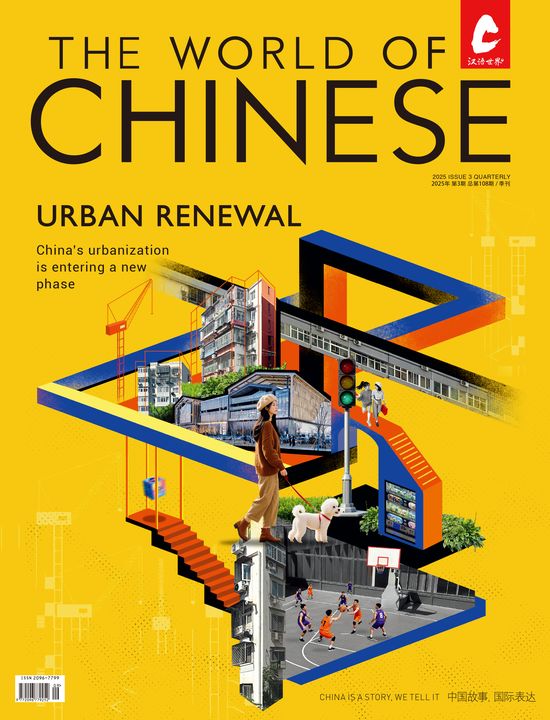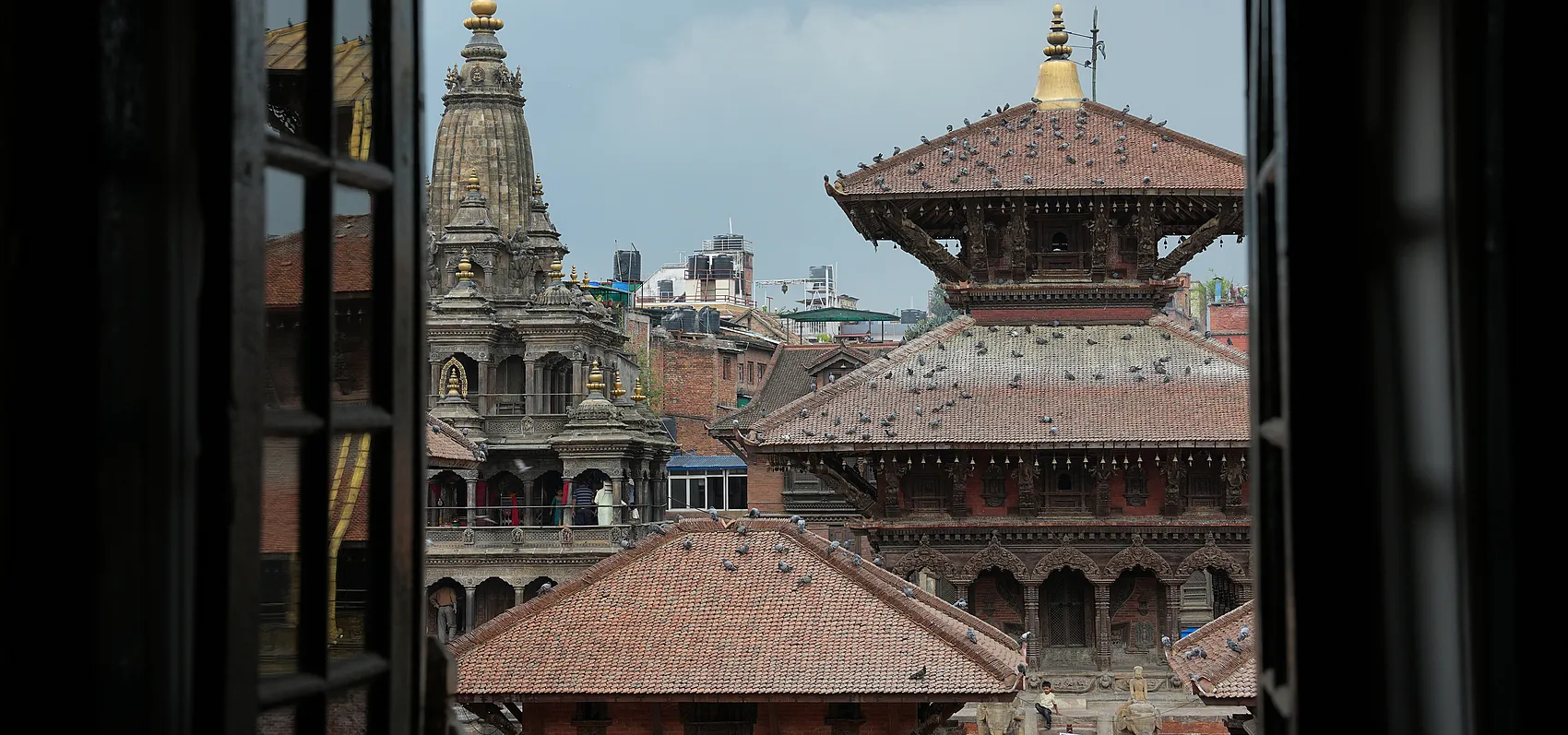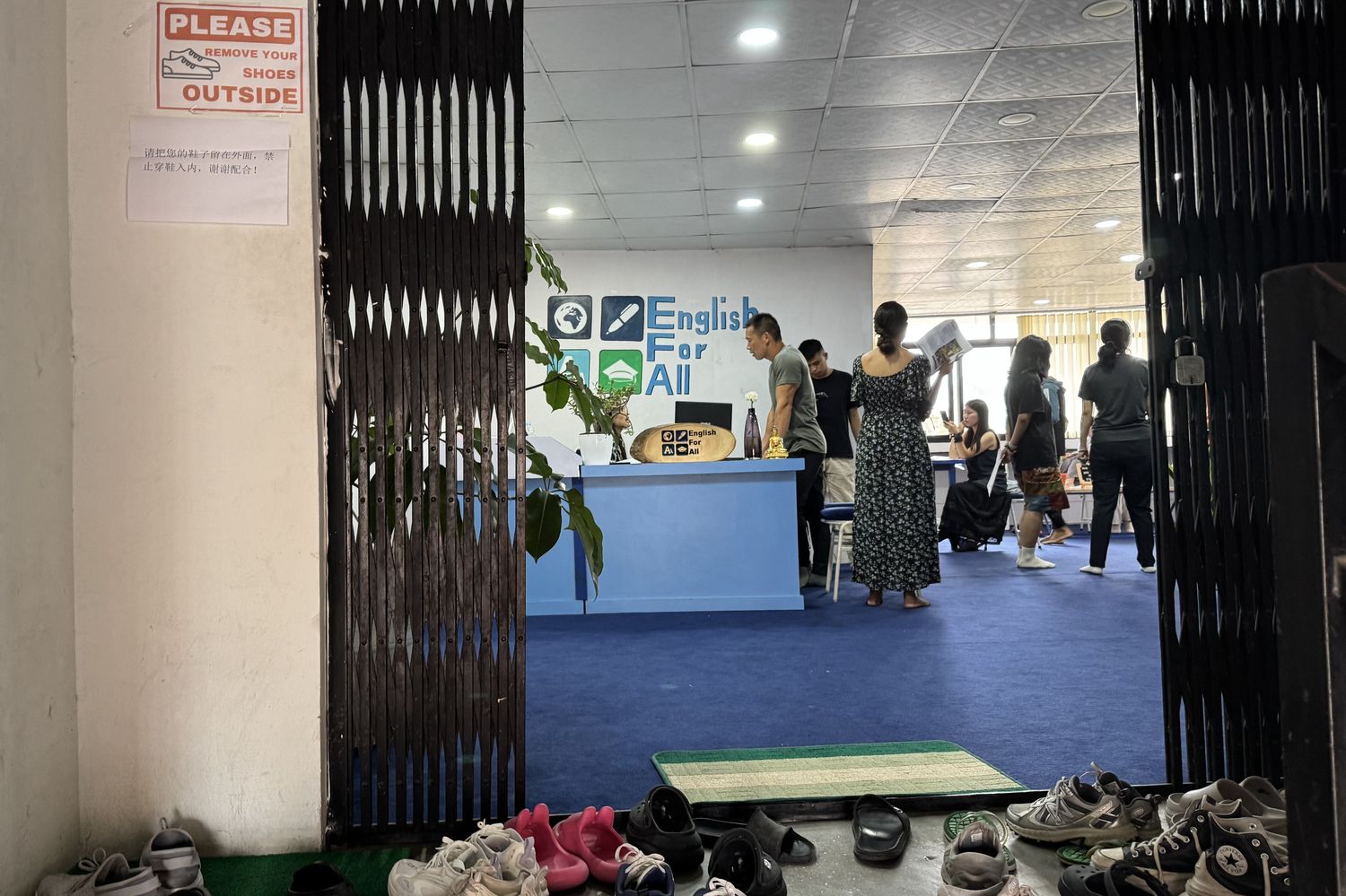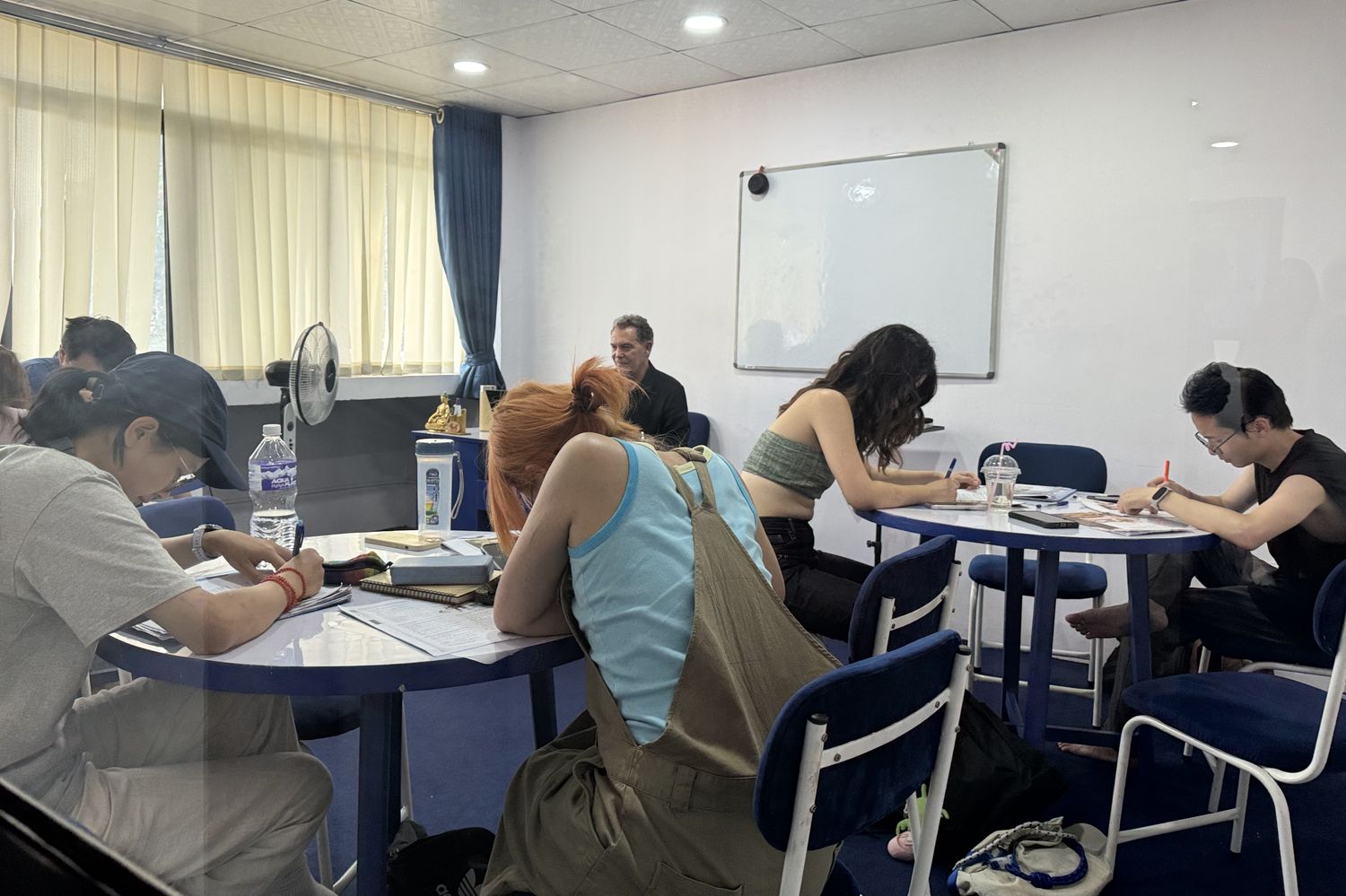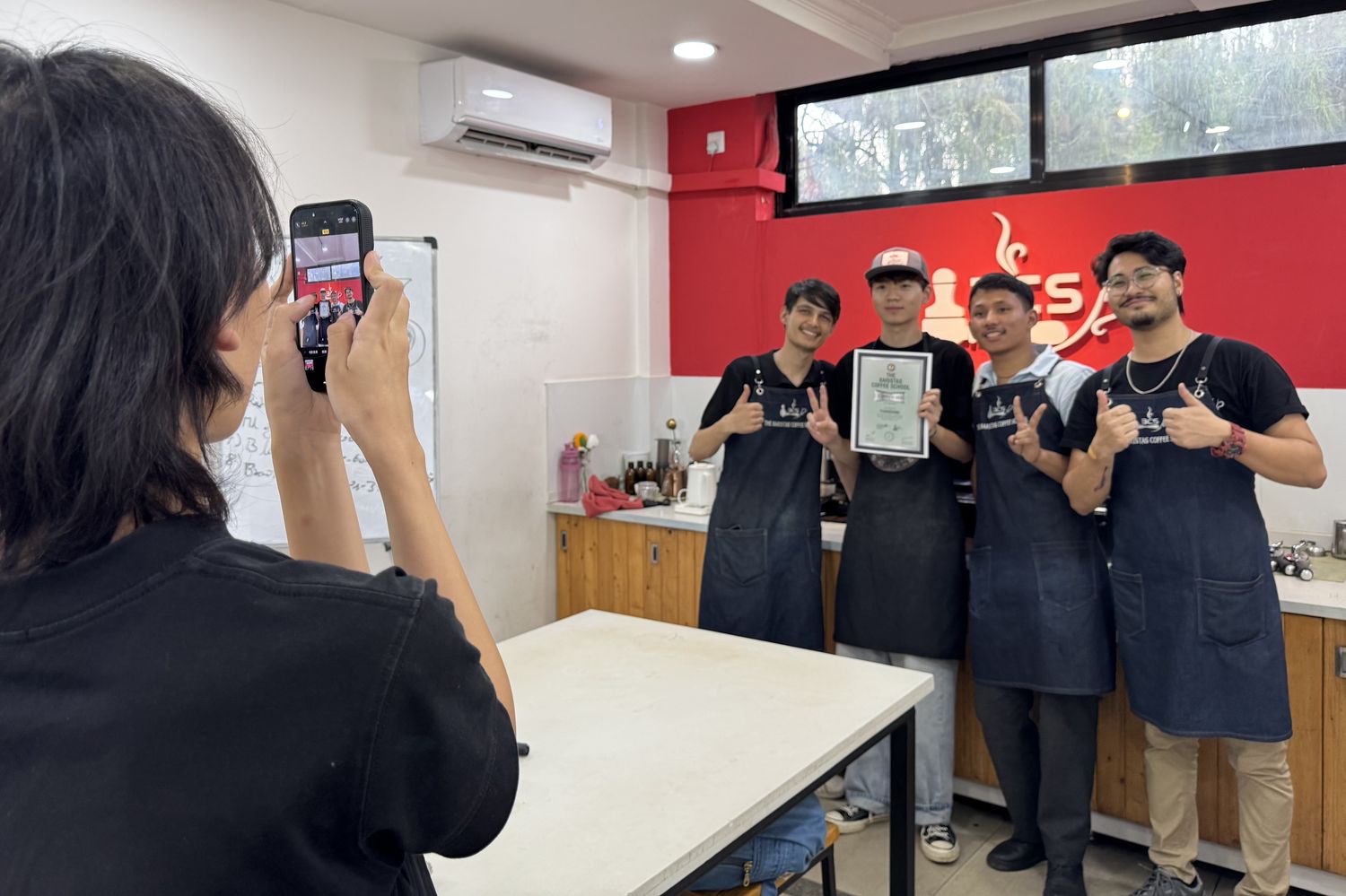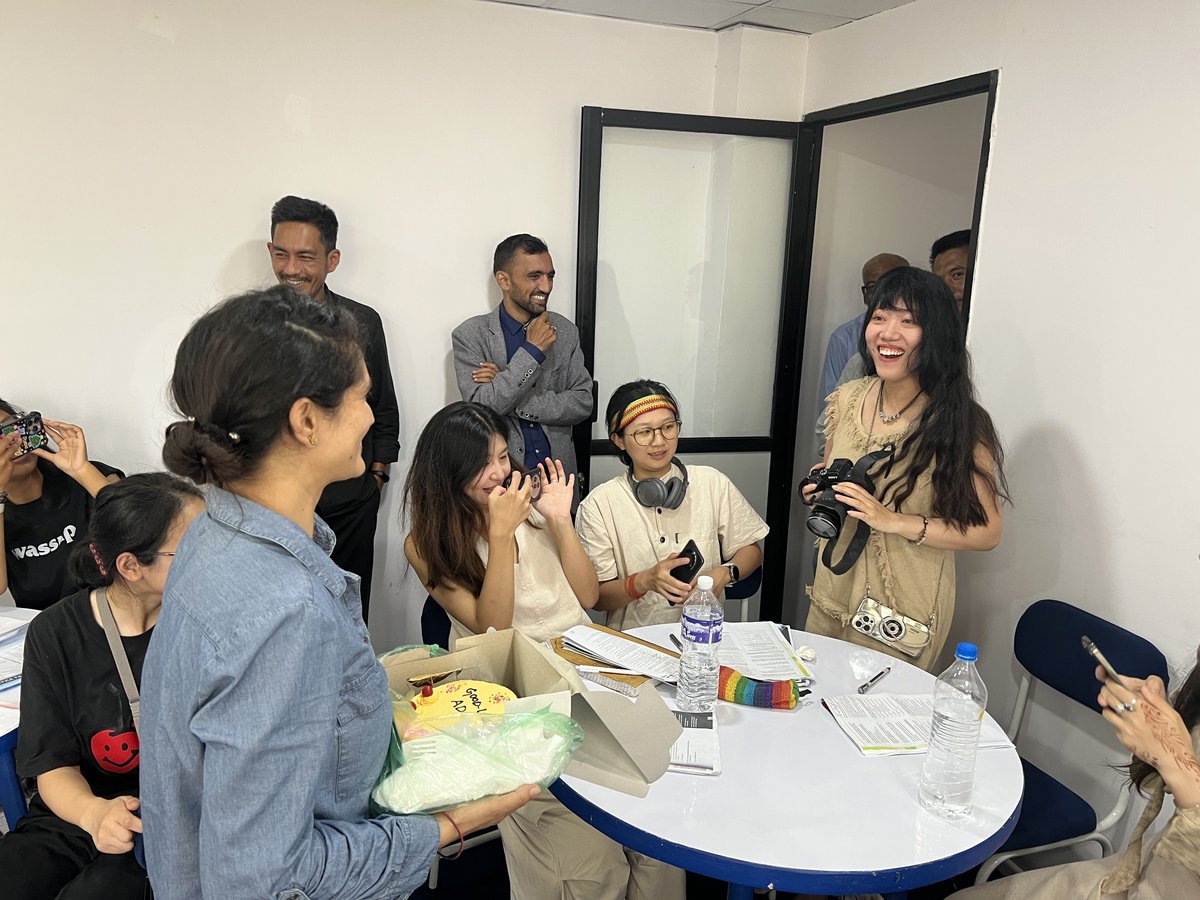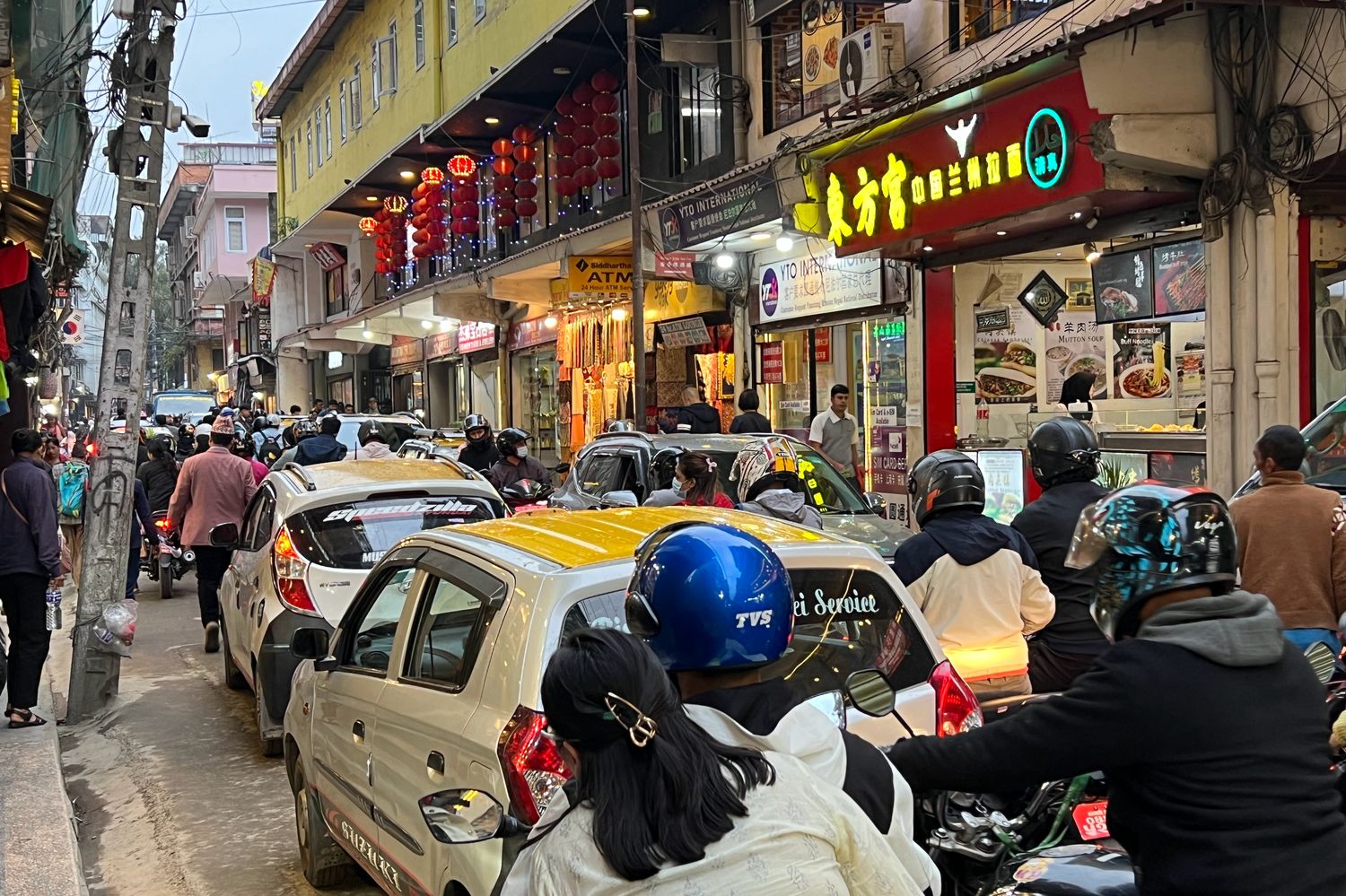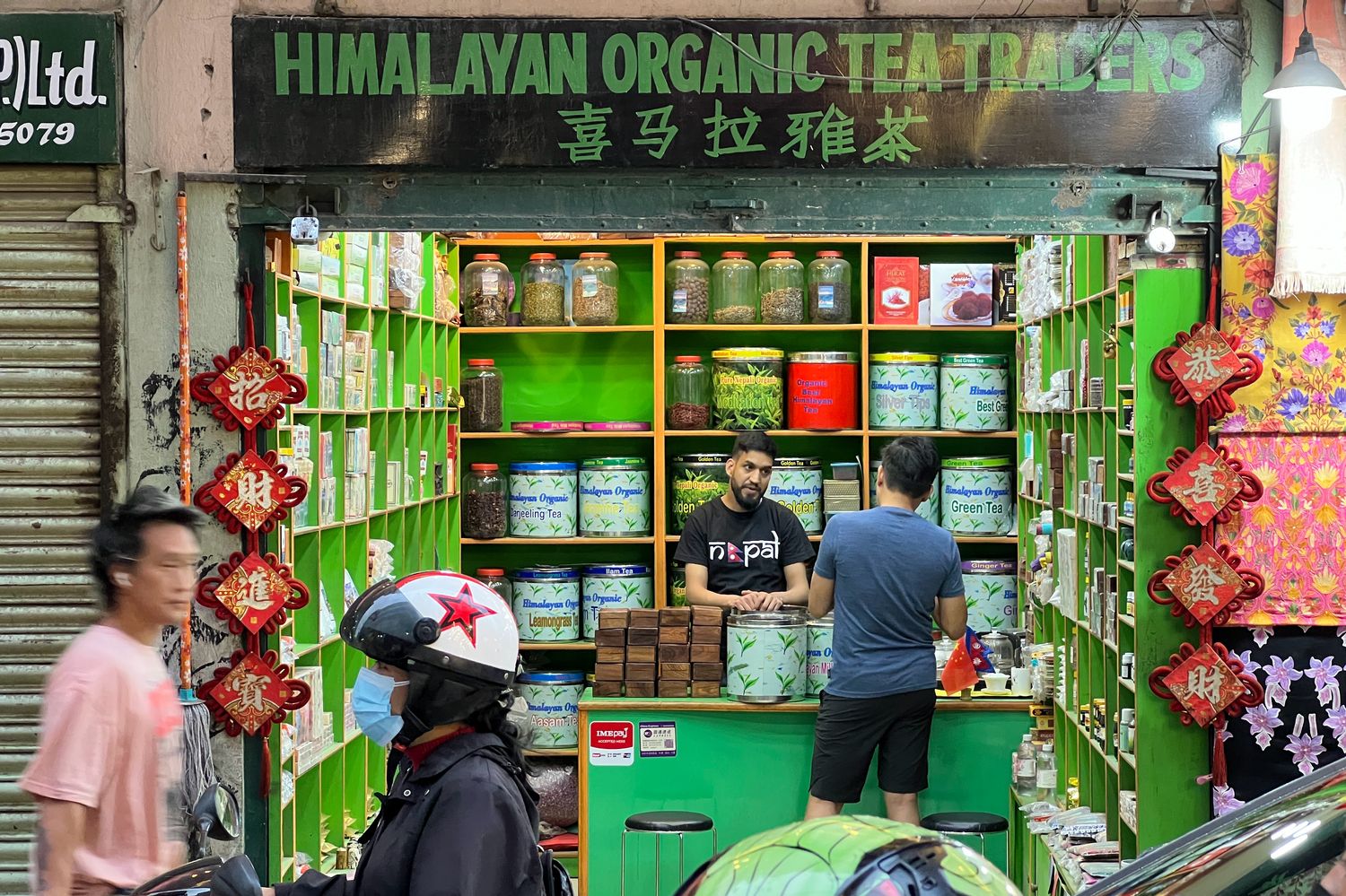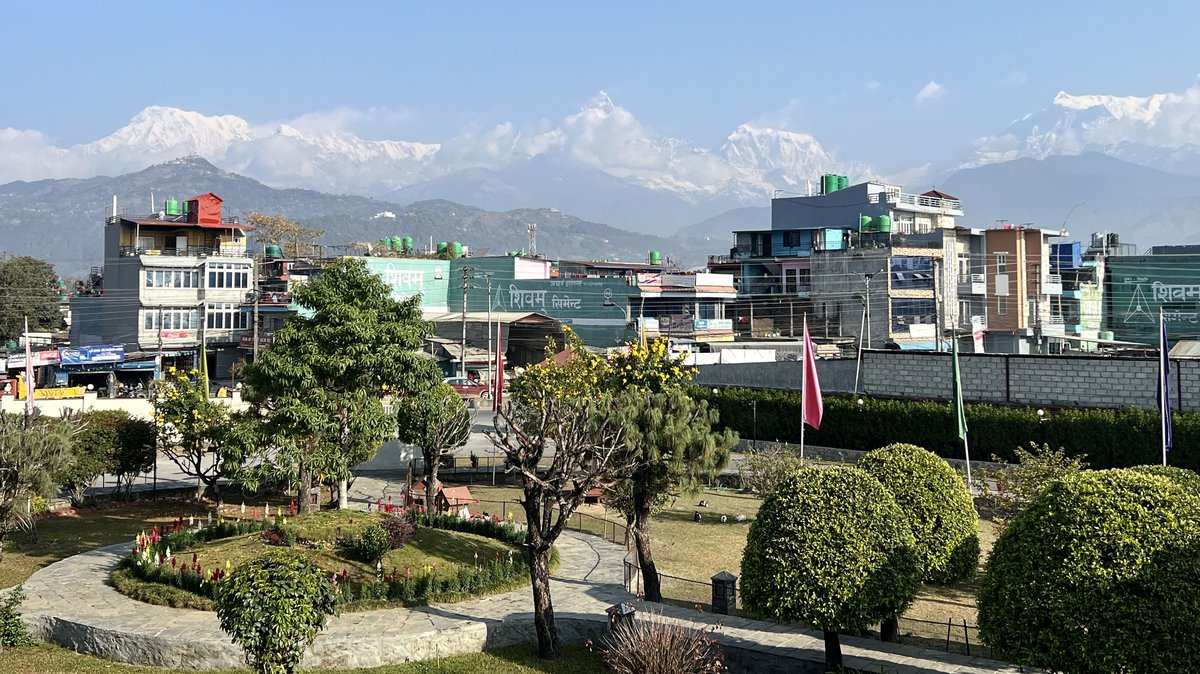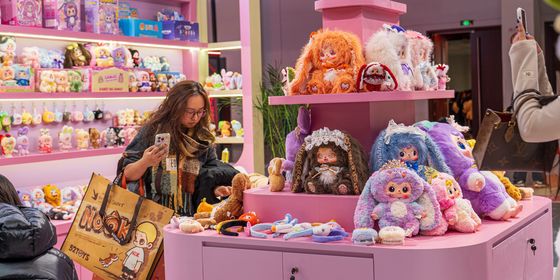More and more young Chinese are flocking to their western neighbor to study, travel, or simply escape the stresses of home life at an affordable rate—but not all leave satisfied, finding living conditions harsher than they had imagined
Outside the lobby of a modest English language school, a sign in Mandarin hangs near the entrance’s rusted iron gate: “No shoes allowed. Thank you.” Rows of dusty sneakers, sandals, and leather loafers line the narrow passage like silent gatekeepers. Just beyond the threshold, a dozen young East Asian faces are scattered in the sweltering lobby, muffled voices in Mandarin rise and fall, before gradually swelling into a loud, chaotic hum.
Inside, around 10 young Chinese students sit in a classroom, hunched over as they complete English listening exercises. Leon Row, the school’s British founder and lead instructor, steps out of the classroom, and with a crisp London accent, gently asks the crowd outside to keep their voices down—the noise is disrupting them.
But this is not a language training center in Shanghai, nor a bootcamp tucked away in some Beijing office park. This is Kathmandu, the capital of Nepal—a country better known for its snow-capped mountains than for speaking English. The air is thinner here, the electricity often flickers on and off, and the clang of temple bells soundtracks morning drills.
Read more about continuing education in China:
- Why China’s Young Urbanites Seek Refuge in Night School
- Degrees of Disillusionment: What’s Driving China’s Certification Craze?
- Meet the Mature Chinese Students Ditching Deadend Jobs to Study Abroad
“Chinese students have flooded in—they now make up around 70 percent of our total enrollment,” Row tells TWOC. “It started to increase from the beginning of the year, but the real surge has come in the past four months.” According to Row, the institute recently added a fourth classroom and expanded its teaching staff to meet demand.
Megan Zhu, a 27-year-old from China’s Hunan province, is one of the newest arrivals at the language school English for All. According to Zhu, she had quit her job the previous Friday and, by Monday, she was in Kathmandu with nothing but a backpack and a plan. “I signed up for classes immediately,” she tells TWOC. “I’ll be here for a month, mainly for English and a barista course. Then maybe I’ll travel a bit once the courses are done.”
Her daily schedule is tightly packed but deliberately unhurried: English classes from 12:30 to 2 p.m. followed by a short walk to a nearby coffee school for her 3 to 4 p.m. barista course. In between, she reviews assignments while sitting outside the school. “It keeps me busy,” she tells TWOC. “But life here feels less rushed.”
Zhu is far from alone. While some young Chinese race through “special forces-style tours (特种兵式旅游)”—snapping photos across the country’s three main cities in 48 hours—others are choosing a slower, more deliberate pace. Since early 2025, a quiet but steady influx of young Chinese in their 20s and 30s has begun to reshape Nepal’s short-term training scene—not only in English classrooms, but at coffee academies, yoga studios, tennis courts, and other skills-based programs. Most come with dual intention—to pick up a skill or two, and to momentarily drop out of China’s hyper-competitive education and work culture. They are not tourists exactly, nor digital nomads, but something in between: soft residents with a schedule.
In a March report, Chinese Media Outlet Ifeng described how “post-90s Chinese are occupying Nepal’s training schools,” noting that affordability, flexible visas, and a break from domestic pressures were key drivers behind the shift. And TWOC’s reporting in Kathmandu confirms that the trend has only accelerated since.
Of the nearly 20 short-term residents we interviewed in Kathmandu, almost all—aside from two 40-something parents attending classes with their children—were aged between 20 and 30 and described themselves as recently unemployed, on unpaid leave, between jobs, or taking a gap before graduation. Classmates by day and playmates come night, a makeshift community has begun to form among this loose-knit cohort of 90s-born wanderers. They hail from vastly different corners of China but tend to share a strikingly similar rhythm, staying for a month or two, or at most five—the visa limit for Chinese tourists—before drifting on. Like migratory birds, they leave home when the urge beckons and return once they’ve had their fill.
Zhu, for instance, was an accountant in Changsha, Hunan’s capital. She described her workload as being manageable, with just a few busy days each month, but her boss’s constant emotional pressure wore her down. “Even when I hit my targets, he made me feel it wasn’t good enough,” she tells TWOC. Considering her company’s leadership, she couldn’t picture a future she wanted. So she quit, and Nepal became her first stop in starting over.
Then there’s Sunny Liu, 29, who took temporary unpaid leave from his state-affiliated job in Nanchang, capital of Jiangxi province, following budget cuts rolled out in mid-2024. He came to study English and prepare for the IELTS, squeezing in weekend hikes near the Kathmandu Valley and taking in the breathtaking Himalayan landscape. Meanwhile, Ada Lu, 32, arrived solo after her education startup collapsed in 2023 following a policy shift that reshaped China’s private tutoring landscape. She spent four months enrolled in English, tennis, barista, and cocktail courses. Vera Guo, a former product manager at a Beijing tech firm, quit her job in late 2024 after months of friction with a new supervisor. She stayed for six weeks, calling it “a structured retreat, not a vacation.”
Why Nepal? In part, because of an official push. China formally declared 2025 the “Visit Nepal Year,” aiming for at least 500,000 of its citizens to visit by year-end—a major increase from the 101,879 Chinese nationals who visited Nepal last year, which itself was a 67 percent increase from 2023. In return, tourism provides a major driver of employment in the country, supporting approximately 1.19 million jobs in 2023—around 15 percent of the country’s total employment.
But young people are especially drawn to Nepal because of its cheap living, and the three interviewees above all traced their fledgling interest in the country back to the same source: Xiaohongshu, China’s Instagram-like lifestyle platform. Here, thousands of posts compare course prices, review language schools, and detail frugal daily budgets—10 yuan for a meal, 30 to 50 for a night at a guesthouse, 25 for an English class, 20 for a guitar lesson, 30 for yoga, and 40 for tennis. With each costing about the price of a cup of coffee back home, basic living can be as low as 3,000 yuan per month. In online communities, the trend has even earned a name: “geographic arbitrage.” The idea is simple—spend less money abroad for the same, or better, experience than you could afford at home.
“In Beijing, a single group tennis session can easily cost 300 to 400 yuan, and yoga classes average between 100 and 200,” Guo tells TWOC. “Here in Nepal, the prices feel almost surreal—like cabbage on clearance. I take two tennis classes in the morning—one as early as 5:30—and three English lessons in the afternoon. At these rates, it’s a steal. You just want to squeeze in as much as you can.”
In turn, the growing presence of Chinese students is quietly reshaping Kathmandu’s training centers—not just in enrollment numbers, but in teaching style and institutional expectations.
“Their intelligence and diligence really impressed me,” says Debendra Pokharel, owner of Cocina Mitho Chha, a hospitality school and hostel that offers classes in baking, cooking, and mixology. “Nepali students tend to work slowly, one careful step at a time. But the Chinese students pick things up quickly and execute even faster. Sometimes they surprise the locals,” he adds.
Still, cultural differences remain. “Nepalis are famously relaxed about time,” Pokharel tells TWOC. “Being late is common. But the Chinese students don’t understand—it stresses them out.”
On the flip side, he notes that Chinese guests occasionally leave without notice. “They just disappear—one day they’re here, and the next, a different Chinese guest has replaced them. No message, no explanation. Maybe they feel awkward? But a quick heads-up would be enough.” To reduce misunderstandings, Pokharel added a Mandarin version of the hostel’s house rules.
At the Barista Coffee School—Kathmandu’s largest coffee training center—head instructor Anryan Kumar KC tells TWOC that Chinese students can make up as much as 60 percent of their student body. The shift has forced them to adapt. “They’re fast learners,” KC says. “But the language barrier is a challenge. Most of them speak very limited English, so we use translation apps—and we’ve picked up some coffee terms in Mandarin: bitter, sweet, sour, milk, latte art, that kind of thing.”
After numerous students requested accelerated lessons, the school designed a condensed three-day latte art program, down from the usual six days, just for Chinese learners. “We even created a special certificate just for the fast-track group,” KC tells TWOC. “It’s working well.”
According to Liu from Nanchang, his schedule in Kathmandu was military-precise—up by 6:15 a.m., out the door before 7, English class until 8:30, followed by a full three-hour mock IELTS test. After lunch and a brief rest, he’d dive into speaking sessions, review corrections, and squeeze in video lectures on test skills until nightfall. But for such disciplined learners, Nepal’s teaching style can feel mismatched.
“The results weren’t as significant as I’d hoped,” Liu tells TWOC. “Nepali instructors emphasize long-term immersion—repetition over technique. One of my instructors told me to forget tricks: Just read 15 minutes a day, watch English YouTube, and let it become part of your life. Real test hacks? You find those on Chinese online learning platforms.”
While affordability was a major draw, Liu noticed that even that is shifting. “When I first checked, one-on-one lessons were 800 rupees—around 40 yuan. By late 2024, that had jumped to 1,200. Now, some charge 2,200. That’s nearly tripled,” Liu tells TWOC. “And this is with no real infrastructure—constant dust, garbage in the streets, barely any public transport. I’m terrified of dogs, and there are strays everywhere.”
Such frustrations reflect deeper structural realities. Nepal remains one of the world’s least developed countries, with a per capita GDP of just 1,440 US dollars in 2024, and limited progress has been made in terms of infrastructure and public services. According to The Kathmandu Post, the capital was ranked the most polluted city in the world in April 2025 amid widespread wildfires, with PM2.5 frequently reaching hazardous levels. A World Bank report in June also named air pollution as the number one risk factor for death and disability in Nepal. For many of these young Chinese, who usually arrive well-informed as to the realities of Nepali life, the actual conditions can still come as a surprise. Patchy electricity, an erratic water supply, congested roads, and visible air pollution are part of daily life.
“I was born in Pingdingshan, a coal-mining city in Henan province—our streets are dusty with coal ash. I thought I could handle anything,” Guo tells TWOC. “But it’s not on the same level. Back home, it was just physical dust; here, it’s physical plus chemical—from exhaust fumes.”
“The tap water runs yellow,” she adds. “Of course, we only use bottled water for drinking and daily needs.”
Guo had originally planned to bring her 4-year-old daughter along to attend classes together, but changed her mind after seeing the city’s conditions. “I’ll wait until she’s older and has a stronger immune system,” she says.
Compared to Kathmandu, the tourist city of Pokhara offers transplants a gentler landing. Nestled beside Phewa Lake and the snow-capped Annapurna mountain range, Pokhara has an altogether slower rhythm, cleaner air, and scenic calm, earning it the nickname “the Dali of Nepal” on Chinese social media, a reference to the idyllic backpacker hub in China’s Yunnan province.
“I spent my first month in Pokhara,” Ada Lu tells TWOC, having now lived in Nepal for three months total. “I ended up spending the rest of my time in Kathmandu,” explaining that’s where her friends are. “It’s dirty, it’s hectic—but it’s also full of life.”
“I didn’t expect this, but maybe that’s the point…We’re all just going with the flow. In this land of gods and miracles, most of us didn’t come expecting miracles. Nepal isn’t about changing your life overnight. It’s a transit stop, a pause—just a place we’re passing through.”
